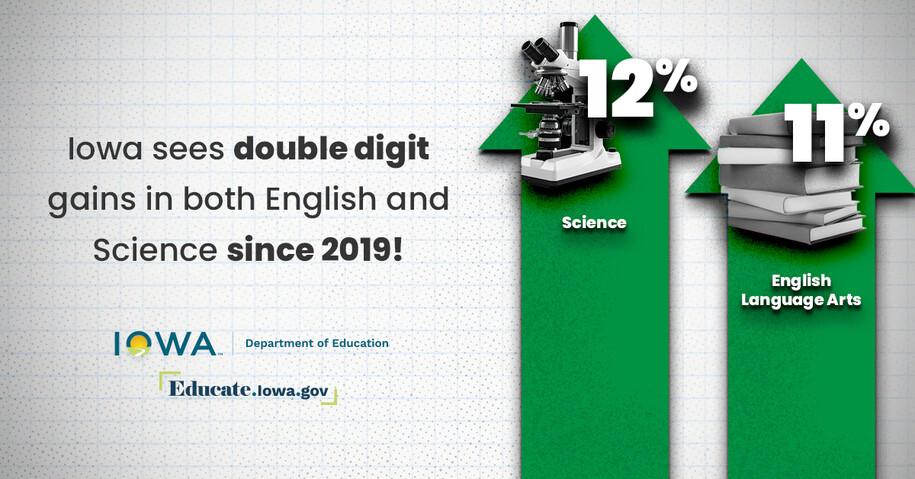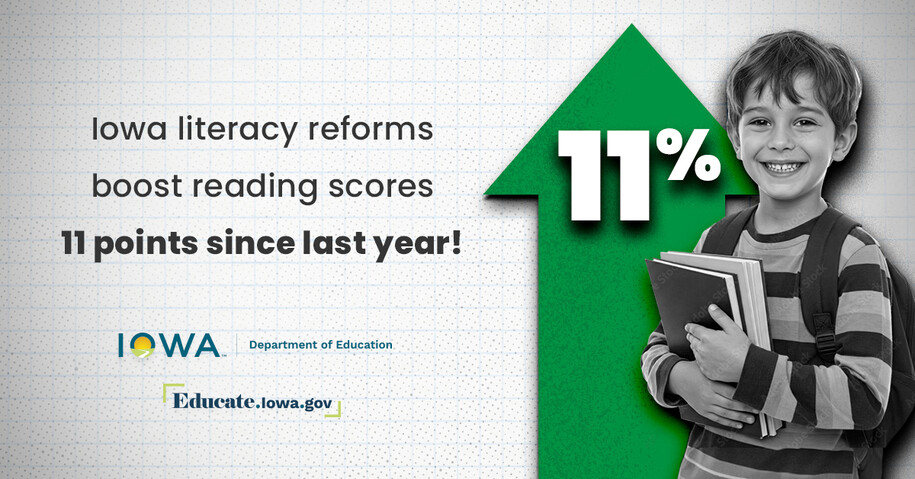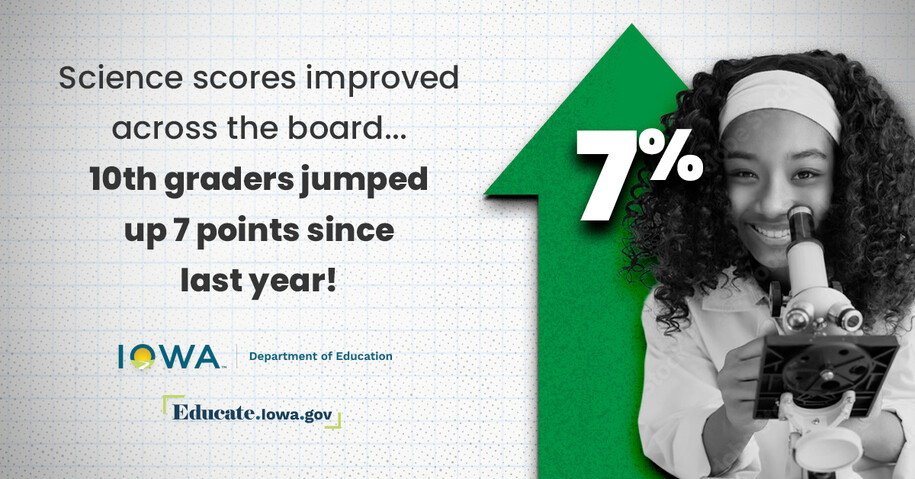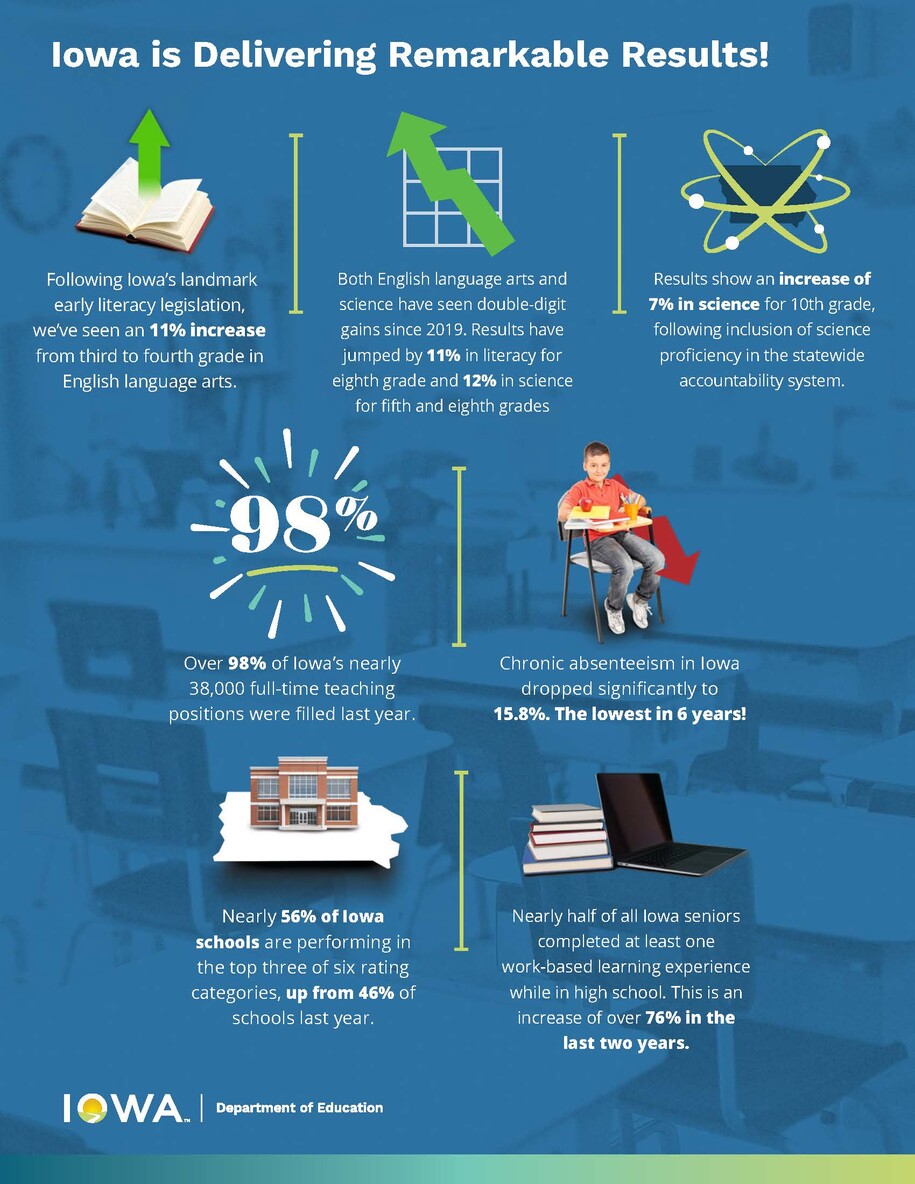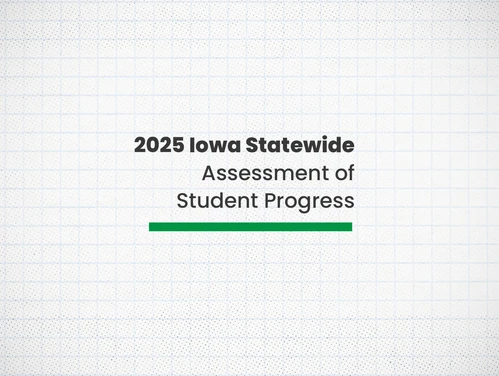Results show notable growth in English language arts and science following statewide early literacy initiatives and inclusion of science in the state’s school accountability system; lagging math proficiency, especially in high school
DES MOINES — The Iowa Department of Education today released new spring 2025 assessment results from the Iowa Statewide Assessment of Student Progress (ISASP) for students in grades 3-11. The state-level results show encouraging improvements in student achievement across most grade levels in English language arts and science, while high school math proficiency rates continue to lag behind those of earlier grade levels.
Overall state-level results from the 2024-25 ISASP show gains in student performance over last year, often surpassing pre-pandemic levels across most grades and subjects. Iowa’s proficiency rates for English language arts (ELA) ranged from 68 to 80 percent while mathematics ranged between 64 and 76 percent. Science ranged between 64 and 70 percent.
“Iowa made literacy a priority in every classroom and for every student over the past year by implementing proven, evidence-based approaches that we know work,” said Governor Kim Reynolds. “By empowering Iowa teachers with critical training in the Science of Reading and through strong collaboration with students, families and school partners, ELA proficiency for last year’s third graders jumped an impressive 11 percentage points just one year later. Together we will continue this transformational work in literacy while also prioritizing math through the implementation of the Math Counts Act to ensure Iowa’s education system is helping every student achieve their potential.”
Following the enactment of landmark early literacy legislation enacted in 2024, students who were in third grade during the 2023-24 school year showed outstanding gains as fourth graders in 2024-25, with ELA proficiency increasing 11 percentage points. Compared to last year, ELA proficiency rates increased or were maintained in grades 3-5 and 8-10, with grades 3 and 8 showing the most significant increases of 4 and 3 percentage points, respectively.
“Over the past two years, Iowa has advanced rigorous academic standards, high-quality instructional materials, early student identification, strong instructional interventions, professional learning, educator preparation, and family-centered resources–and our collective work has made a remarkable difference for students across Iowa,” said Iowa Department of Education Director McKenzie Snow. “Together, we celebrate the extraordinary gains of our young readers and the leadership of Iowa’s teachers and families in implementing these comprehensive, statewide investments in evidence-based instruction.”
Math proficiency in high school grades is much lower than that of earlier grade levels, with differences ranging between 4 to 12 percentage points lower. Students in ninth grade experienced the largest long-term decrease in math proficiency, down 5 percentage points from 2019. Compared to last year, math proficiency rates do not show change beyond 1-2 percentage points, reinforcing the need for the Math Counts Act passed in 2025.
“The data show Iowa’s investment in evidence-based literacy instruction is working, and, last winter, we set out to mirror these transformational structures in math through the historic Math Counts Act,” said Snow. “Heartened by student progress and determined to meet student needs, Iowa will continue to reassert our commitment to evidence-based instruction that improves student achievement and narrows and closes achievement gaps.”
Following the recent passage of the Math Counts Act, Iowa is implementing new statewide supports for mathematics teaching and learning. This will include early identification and progress monitoring for students who are not on track to be proficient, personalized math plans and interventions for students in need of support, evidence-based professional development for teachers, alignment of Iowa’s educator preparation programs to evidence-based instruction and availability of family-centered resources to support children’s mathematics development at home.
In the 2024-25 school year, science proficiency was included in Iowa’s new, unified school accountability system for the first time. This spring, science proficiency rates show gains across all tested grades, exceeding pre-pandemic performance with a 12-percentage point increase in both 5th and 8th grade since 2019. In just one year, science proficiency increased by 4 percentage points in 5th grade, 5 percentage points in 8th grade, and 7 percentage points in 10th grade.
“Instructional leadership and accountability matter, and we commend our students, educators, and families for the long-term progress and exceptional improvements made following the inclusion of science proficiency in our new accountability system last year,” said Snow.
While the data show some long-term narrowing of proficiency gaps between overall student results and those of certain student groups, significant proficiency gaps persist. Students with disabilities and students who are English learners experienced much lower proficiency rates than their classmates, with average differences across grade levels in ELA proficiency of 45 and 53 percentage points, respectively. The average proficiency rate gaps in mathematics for students with disabilities and students who are English learners was slightly lower at 41 and 45 percentage points, respectively.
The ISASP is administered each spring and is the general summative accountability assessment in Iowa that meets the requirements of the Every Student Succeeds Act (ESSA). The assessment reflects what’s being taught in Iowa classrooms and how students are progressing toward grade-level expectations outlined in Iowa’s academic standards. The ISASP helps teachers understand where students are succeeding and where they may need more help.
The spring 2025 ISASP results, proficiency rates by public district, public school building, nonpublic school building and fact sheet with additional graphs and charts can be found on the Iowa Department of Education’s PK-12 Education Statistics webpage.
